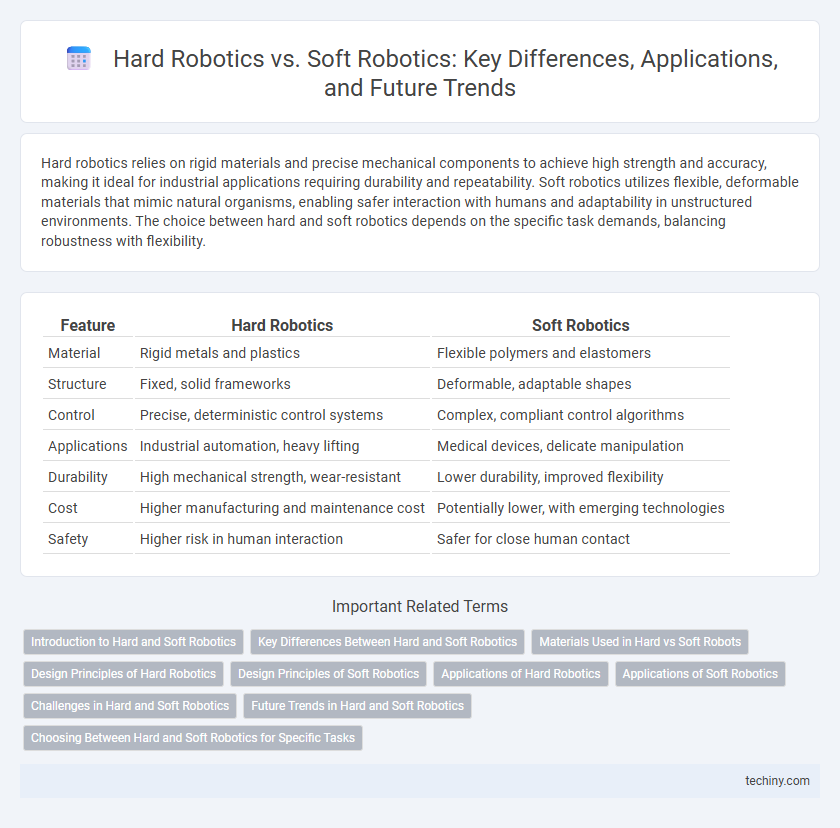Hard robotics relies on rigid materials and precise mechanical components to achieve high strength and accuracy, making it ideal for industrial applications requiring durability and repeatability. Soft robotics utilizes flexible, deformable materials that mimic natural organisms, enabling safer interaction with humans and adaptability in unstructured environments. The choice between hard and soft robotics depends on the specific task demands, balancing robustness with flexibility.
Table of Comparison
| Feature | Hard Robotics | Soft Robotics |
|---|---|---|
| Material | Rigid metals and plastics | Flexible polymers and elastomers |
| Structure | Fixed, solid frameworks | Deformable, adaptable shapes |
| Control | Precise, deterministic control systems | Complex, compliant control algorithms |
| Applications | Industrial automation, heavy lifting | Medical devices, delicate manipulation |
| Durability | High mechanical strength, wear-resistant | Lower durability, improved flexibility |
| Cost | Higher manufacturing and maintenance cost | Potentially lower, with emerging technologies |
| Safety | Higher risk in human interaction | Safer for close human contact |
Introduction to Hard and Soft Robotics
Hard robotics relies on rigid materials such as metals and plastics to build precise, durable machines designed for high-strength tasks and predictable environments. Soft robotics employs flexible, deformable materials like silicones and elastomers to create adaptable, compliant systems that mimic biological movement and excel in unstructured or delicate interactions. Both approaches address unique challenges in automation, with hard robotics favored for industrial applications and soft robotics advancing capabilities in healthcare, agriculture, and human-robot interaction.
Key Differences Between Hard and Soft Robotics
Hard robotics utilizes rigid materials like metals and plastics to create precise, durable, and highly controllable machines, often applied in industrial automation. Soft robotics employs flexible, compliant materials such as silicones and gels, enabling safe interaction with uncertain or dynamic environments, ideal for delicate tasks like medical surgeries or wearable devices. Key differences lie in material composition, flexibility, adaptability, and application scope, with hard robotics excelling in strength and repeatability, while soft robotics prioritizes safety and versatility.
Materials Used in Hard vs Soft Robots
Hard robotics predominantly utilize rigid materials such as metals, plastics, and carbon fiber composites to ensure structural strength and precise movement control. Soft robotics employ flexible and deformable materials like silicones, elastomers, and hydrogels, enabling adaptability and safe interaction with unpredictable environments. The contrast in material properties directly influences the functional capabilities, durability, and application domains of both hard and soft robotic systems.
Design Principles of Hard Robotics
Hard robotics relies on rigid materials such as metals and plastics, emphasizing precise control, structural stability, and durability in its design principles. Mechanical components are engineered for specific, repeatable tasks, often employing gears, motors, and sensors to achieve high accuracy and load-bearing capacity. This approach facilitates robust performance in industrial automation, manufacturing, and environments requiring strict reliability and precision.
Design Principles of Soft Robotics
Soft robotics design principles emphasize compliance, adaptability, and biomimicry, utilizing materials like silicones, elastomers, and hydrogels to achieve flexible, deformable structures. These systems rely on pneumatic or hydraulic actuators, embedded sensors, and modular components to replicate organic movement and enhance interaction safety in unstructured environments. Unlike hard robotics, soft robotic designs prioritize distributed actuation and fluidic networks, enabling complex, multi-degree-of-freedom motions with inherent resilience to mechanical stress.
Applications of Hard Robotics
Hard robotics excels in precision-driven applications such as automotive manufacturing, aerospace assembly, and medical surgery where rigid structures and high strength are essential. Industrial robots with metal frames and hydraulic actuators dominate environments requiring heavy payload handling, repetitive tasks, and high-speed operations. Their robust design ensures longevity and consistent performance in harsh conditions, making them vital in large-scale production and hazardous exploration.
Applications of Soft Robotics
Soft robotics offers significant advantages in applications requiring delicate manipulation and adaptability, such as medical surgery, prosthetics, and wearable devices. Its flexible materials and compliant structures enable safer human-robot interactions and enhanced environmental adaptability compared to traditional hard robotics. These characteristics make soft robots ideal for tasks in unpredictable or dynamic settings like agriculture, underwater exploration, and rehabilitation therapies.
Challenges in Hard and Soft Robotics
Hard robotics faces challenges in achieving flexibility and adaptability due to rigid materials and complex mechanical structures, limiting its use in unstructured environments. Soft robotics struggles with precise control and durability because of the compliant and deformable materials that complicate actuation and sensing. Both fields seek to balance robustness and responsiveness while addressing energy efficiency and real-time feedback integration.
Future Trends in Hard and Soft Robotics
Future trends in hard robotics emphasize advancements in precision, durability, and integration with AI for industrial automation, enhancing tasks like assembly and quality control. Soft robotics is evolving towards biocompatible materials and flexible actuators, enabling innovations in medical devices and wearable technology. The convergence of hard and soft robotics is expected to create hybrid systems combining structural strength with adaptability for diverse applications.
Choosing Between Hard and Soft Robotics for Specific Tasks
Hard robotics excels in tasks requiring high precision, durability, and strength, such as industrial automation and heavy-duty manufacturing. Soft robotics offers superior flexibility, adaptability, and safe human-robot interaction, making it ideal for delicate or unpredictable environments like medical assistance and agriculture. Selecting between hard and soft robotics depends on the specific application requirements, including the need for rigidity, compliance, and environmental conditions.
Hard robotics vs soft robotics Infographic

 techiny.com
techiny.com